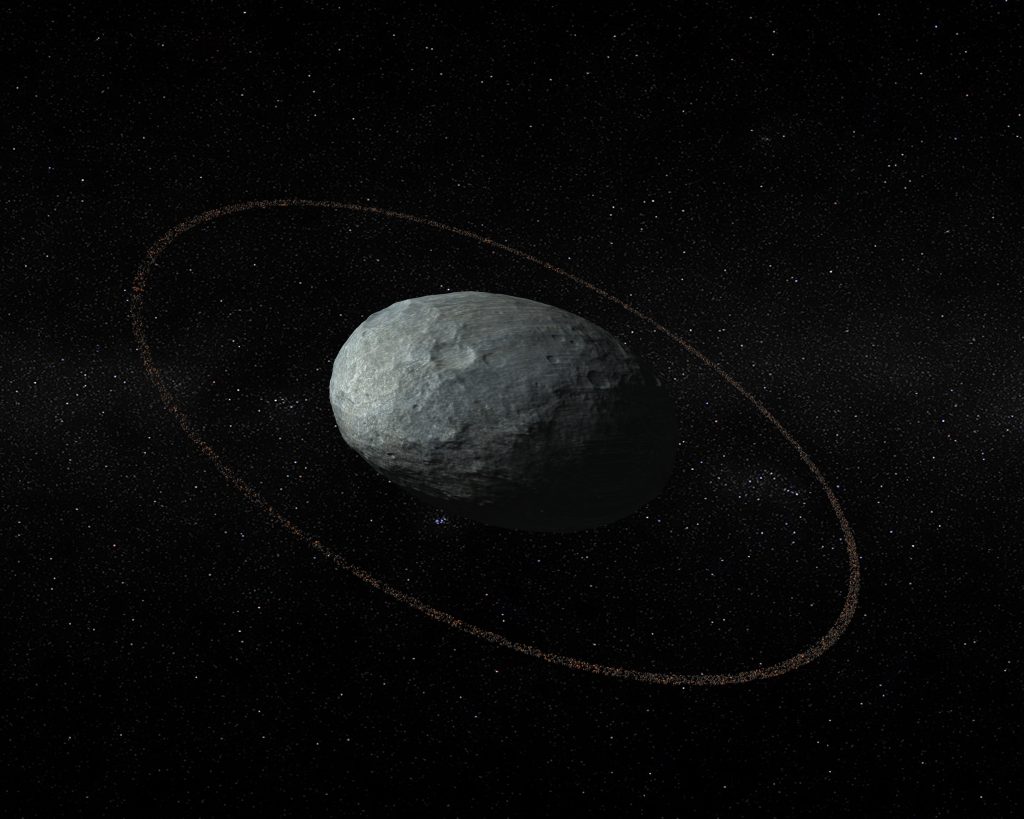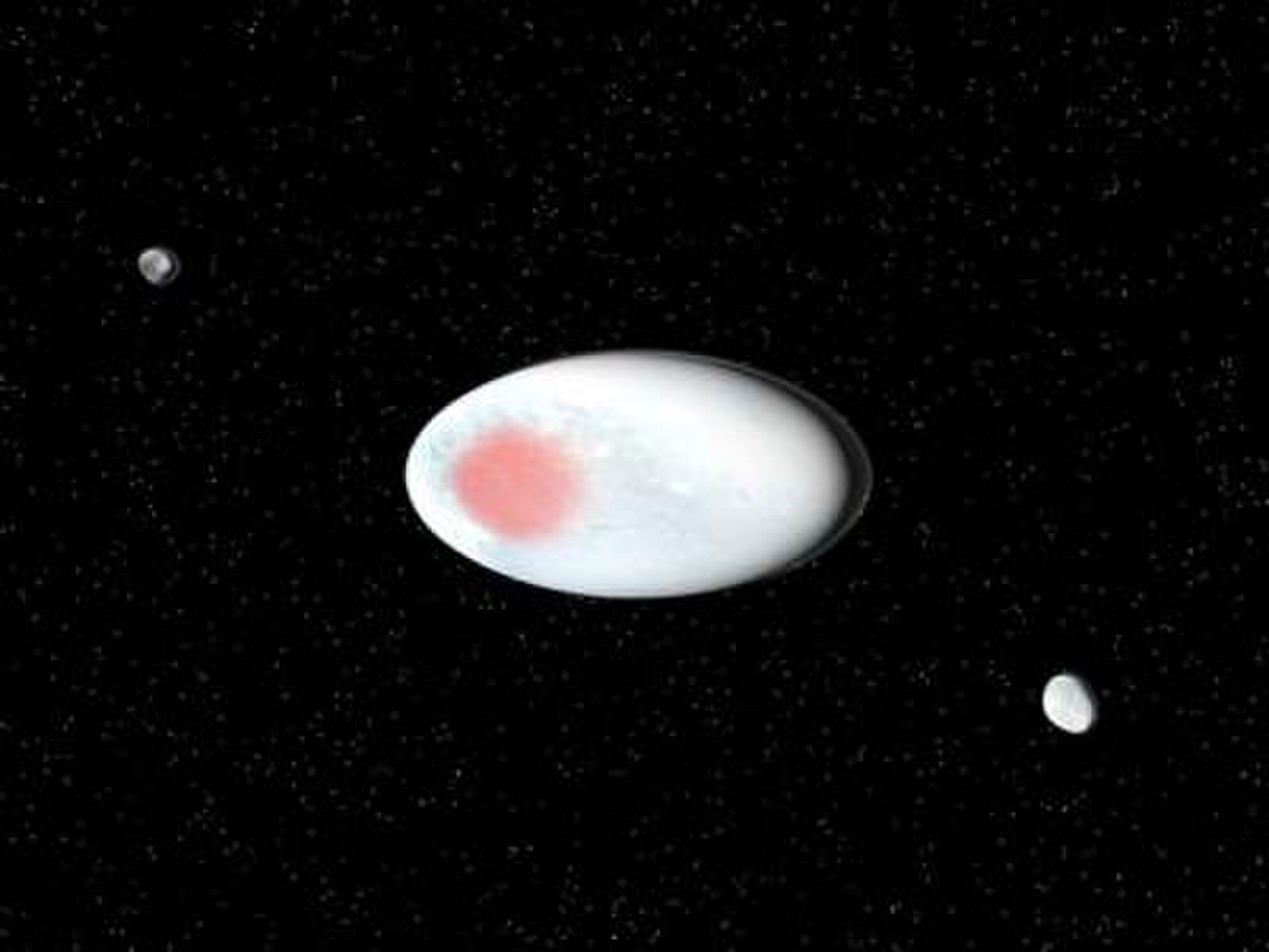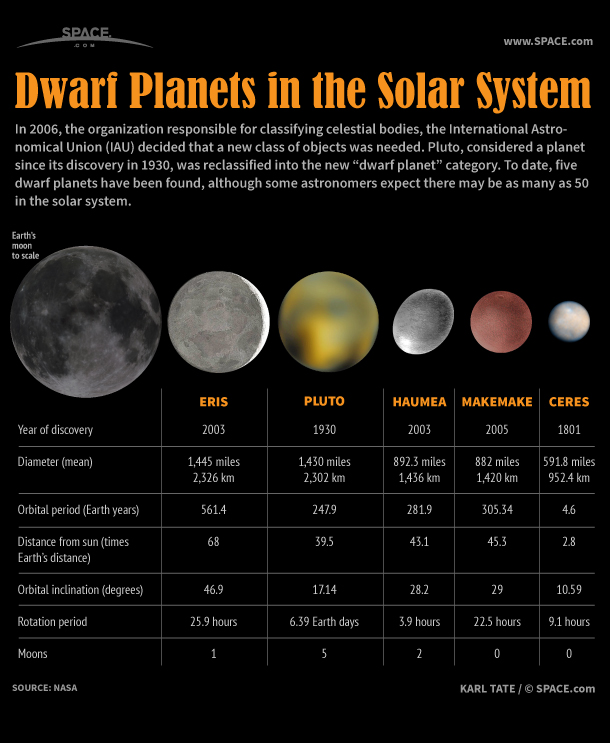Surprise! Bizarre Dwarf Planet Haumea Has Rings
Scientists have discovered a ring system around the dwarf planet Haumea.
Earlier this year, Haumea passed between Earth and a distant star, allowing planetary scientists to get a better idea of the dwarf planet's shape and size. The new findings were announced today (Oct. 11) in the journal Nature.
Haumea is one of the largest objects inhabiting an area beyond Neptune known as the Kuiper Belt. Pluto is the region's largest resident, and Haumea shares some characteristics with its larger neighbor. Both take a highly elongated path around the sun that crosses the orbits of other planetary bodies; Pluto crosses Neptune's orbit, and Haumea crosses Pluto's. Also, both dwarf planets orbit at an angle to the paths of the eight planets, which circle the sun along a common plane. Also like Pluto, Haumea has moons — at least two, Hi'iaka and Namaka. [Meet the Dwarf Planets of Our Solar System (Slideshow)]

Haumea is at least twice as long in one direction as it is in the other, which makes it look more like a river rock than a respectable planet. Scientists think Haumea's incredibly fast rotation may have spun it into this shape. A day on Haumea lasts only 4 hours, making it the fastest-spinning large object known to exist in the solar system.
A cosmic alignment
Scientists had the chance to learn more about this space oddity when Haumea passed in front of the star URAT1 533-182543 on Jan. 21, 2017. Although objects pass in front of stars quite often, it's difficult to accurately predict the specific time and location of these events, study co-author Pablo Santos Sanz told Space.com. Santos Sanz is an astrophysicist at the Instituto de Astrofísica de Andalucía in Granada, Spain.
Santos Sanz's team coordinated 12 telescopes, from 10 different labs, to observe starlight blocked by Haumea and thus better determine its size and shape. Normally, shadows are larger than the objects that cast them. For instance, you can move your hand closer and farther from a flashlight to make its shadow grow and shrink. But the star was so far from Earth relative to Haumea that it projected the dwarf planet's shadow at full size.
"This is a very powerful technique … to obtain sizes," Santos Sanz said. The researchers discovered that Haumea's longest axis is at least 1,430 miles (2,300 kilometers) across — 17 percent larger than previous estimates.
Get the Space.com Newsletter
Breaking space news, the latest updates on rocket launches, skywatching events and more!


The more accurate measurements of Haumea enabled the astronomers to calculate many of the dwarf planet's other properties. Factoring in the rotation gave them its 3D shape and volume. Combining this with its mass — derived from the orbits of its moons — yielded Haumea's density. It was lower than previous estimates, Santos Sans said, but was closer to that of other Kuiper Belt objects, like Pluto.
But these new measurements may cost Haumea its dwarf-planet status. Although many planets and dwarf planets are not perfect spheres — Earth, for instance, bulges a bit at the equator — they are all large enough to have become round due to their own gravity. In contrast, most smaller objects don't have enough gravity to overcome their own rigidity, so they end up oddly shaped or lumpy. This criterion is central to the contentious definition of a dwarf planet, and the more accurate picture of Haumea that emerged from the study appears not to meet it.
"I don't know if this will change the definition [of a dwarf planet]," Santos Sanz said. "I think probably yes, but probably it will take time."
Most surprisingly, the scientists learned that Haumea has rings.
The night Haumea crossed in front of the distant star, Santos Sanz and team leader José Luis Ortiz, also of the Instituto de Astrofísica de Andalucía, looked at the new data.
"We started to see something weird in the light curve," Santos Sanz said. The light dimmed just before and after Haumea passed in front of the star, as if something else were obscuring it. "I remember that José Luis, from the first [moments], said, 'OK, this could be a ring,'" Santos Sanz said. Months of scrutiny bore out the scientists' initial suspicions: The results suggest that Haumea's equator is encircled by a 43-mile-wide (70 km) ring of debris located about 620 miles (1,000 km) from the dwarf planet's surface.
"Rings are usually the sign of a collision that happened not too long ago," Yale astronomer David Rabinowitz, who is unaffiliated with the study, told Space.com. For Rabinowitz, this means sometime between several hundred-million years ago and one billion years ago. The search for the rings' origin makes the system that much more interesting, he added. It's another mystery about the dwarf planet begging for an answer.
Connecting the dots
Haumea's unusual features — its rings, moons and unusual shape — may be linked. In 2007, a team at Caltech tracked the orbits of Haumea, its two moons (Hi'iaka and Namaka) and a few Kuiper Belt objects that share the system's high water-ice content, which is uncommon in objects beyond the orbit of Neptune. According to the study, mathematical models suggest that all of these objects originated when a younger, larger Haumea smacked into another large Kuiper Belt object. The collision sent fragments flying and whipped the dwarf planet into a dizzying spin. Some of these fragments went on their own way around the sun, two might account for Haumea's moons and the remaining dust might have settled to become a ring, according to the study. [The Solar System's Dwarf Planets Explained (Infographic)]
Both Santos Sanz and Rabinowitz cautioned against drawing conclusions too quickly, though. "It's only one of the theories," Santos Sanz said. "It's not definite."
Haumea is not the smallest known object with rings. In 2013, astronomers identified rings around the 188-mile-wide (302 km) asteroid Chariklo, and in 2015, researchers announced that a similar asteroid, Chiron, may have rings as well. Researchers think the two objects, which belong to a group of asteroids known as Centaurs, might also hail from the Kuiper Belt, suggesting that rings may be more common in these objects than scientists previously thought.
"I'm also pretty sure that in the next five years, we will see more rings," Santos Sanz said.
"I think the very exciting thing is that we are at the beginning of this science about rings around minor bodies," he added. "So we don't know many things, but we are learning more and more with each new discovery."
Email Harrison Tasoff at htasoff@space.com or follow him @harrisontasoff. Follow us @Spacedotcom, Facebook and Google+. Original article on Space.com.
Join our Space Forums to keep talking space on the latest missions, night sky and more! And if you have a news tip, correction or comment, let us know at: community@space.com.

Harrison Tasoff is a science journalist originally from Los Angeles. He graduated from NYU’s Science, Health, and Environmental Reporting Program after earning his B.A. in mathematics at Swarthmore College. Harrison covers an array of subjects, but often finds himself drawn to physics, ecology, and earth science stories. In his spare time, he enjoys tidepooling, mineral collecting, and tending native plants.









